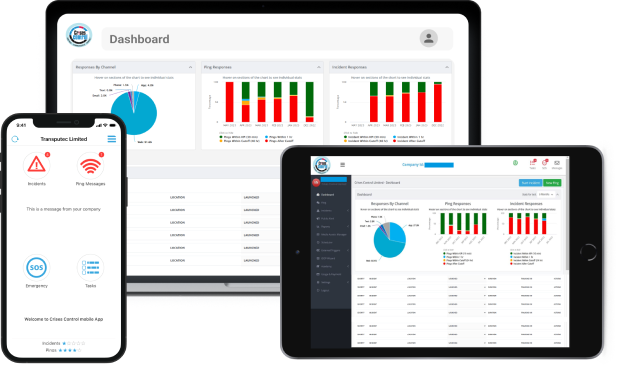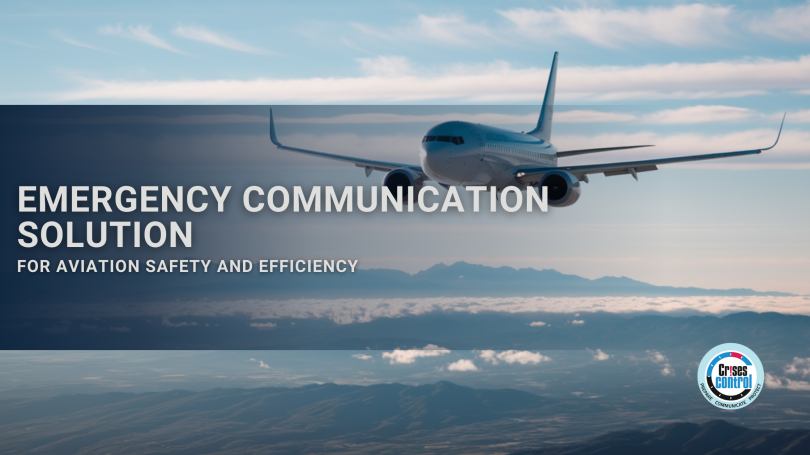Written by Ikram Tassi | Marketing
In the aviation industry, safety isn’t just a priority—it’s the cornerstone of everything. From routine operations to unforeseen emergencies, how quickly and effectively you communicate during a crisis can mean the difference between a controlled situation and a full-blown disaster.
Whether it’s a medical emergency on a flight, an unexpected weather event causing delays, or a security threat at an airport, emergency communication solutions are essential for ensuring that the right people are alerted and able to take action. However, many aviation companies still rely on outdated communication systems that fail to deliver the real-time alerts needed to respond swiftly and decisively.
In this blog, we’ll explore why emergency communication solutions for aviation are so critical, the problems caused by ineffective communication during crises, and how Crises Control can provide the tools necessary to ensure your aviation operations stay safe and efficient in the face of emergencies.
The Critical Role of Emergency Communication Solutions in Aviation
Why Real-Time Alerts Are Non-Negotiable in Aviation Emergencies
Every second counts when responding to a crisis in aviation. From a technical malfunction to a medical emergency or even a security incident, there’s no room for delays. The faster the right people can be notified, the faster the response can be coordinated, and the better the outcome will be.
Real-time alerts are at the heart of any emergency communication system. Whether it’s a pilot alerting the ground crew to an issue, security personnel being informed of a threat, or medical teams being notified about an in-flight emergency, real-time communication ensures everyone is on the same page.
Crises Control ensures these alerts reach the right people immediately, whether they’re on the tarmac, in the air, or in an office miles away. By using automated, multi-channel communication methods such as SMS, email, and in-app notifications, your teams receive immediate updates, no matter where they are.
The Consequences of Ineffective Communication During a Crisis
When Communication Breaks Down, Safety Is Compromised
In aviation, a communication breakdown can quickly escalate a manageable crisis into something far more dangerous. Without the ability to communicate efficiently in emergencies, confusion can spread, critical steps can be missed, and situations can spiral out of control.
The same applies to operational issues like severe weather conditions causing flight delays. If air traffic controllers and ground crew aren’t alerted in real-time about weather changes or the resulting delays, it can lead to flight rescheduling confusion, chaos in the terminal, and ultimately frustrated passengers.
A reliable emergency communication system helps prevent such chaos by ensuring that all teams are immediately updated with accurate information, minimising confusion and maximising the effectiveness of the response.
How Emergency Communication Solutions Improve Safety and Efficiency in Aviation
Enhancing Safety Protocols with Automated Alerts
Safety is, of course, the number one priority in aviation. But what happens when critical information is delayed or lost in the shuffle? Safety protocols rely on swift and clear communication, and any delay can result in catastrophic consequences.
Crises Control ensures that, when an emergency occurs, the necessary steps can be taken immediately. For example, in the case of an in-flight medical emergency, Crises Control allows flight attendants to send an alert directly to ground medical teams, ensuring they are prepared for a quick intervention as soon as the plane lands.
Moreover, Crises Control can help ensure compliance with regulations governing aviation safety by streamlining communication between flight crews, air traffic controllers, and emergency response teams. This seamless integration helps you maintain the required safety standards while ensuring a faster and more effective emergency response.
Streamlined Coordination Across Multiple Teams
Aviation crises often involve multiple teams that need to be in constant communication with one another. Whether it’s a medical issue requiring input from doctors, nurses, and flight attendants, or a security incident needing coordination between airport security, law enforcement, and ground personnel, effective communication is essential to managing the situation efficiently.
Crises Control allows all teams to receive real-time alerts about the incident, making sure everyone is working from the same playbook. The system also provides a platform where teams can exchange information and updates as the crisis unfolds, ensuring that every decision is informed and timely.
For example, if there’s a weather-related disruption causing delays, pilots, air traffic controllers, and ground crew can all be notified of the exact nature of the delay, the steps that need to be taken, and how to keep passengers informed, all at once. This coordinated approach reduces delays, keeps the operation running smoothly, and ensures passenger safety.
Real-World Applications: How Crises Control Can Help Aviation Companies
Medical Emergencies: Time Is Critical
Medical emergencies on flights happen more often than you might think, and when they do, they require fast action. With Crises Control, flight crews can send alerts to medical teams on the ground, providing them with critical details about the passenger’s condition and ensuring that the necessary resources are available when the aircraft lands.
This level of coordination can be lifesaving. By preparing the medical team in advance, response times are reduced, and the passenger is given the best chance for a successful outcome.
Weather-Related Disruptions: Minimising the Impact
Weather is one of the most unpredictable and disruptive elements in aviation. Bad weather can lead to flight delays, cancellations, and changes to routes, all of which require clear communication to minimise the impact on passengers and operations.
With Crises Control, weather-related disruptions are handled efficiently by notifying everyone involved—flight crews, ground staff, air traffic controllers, and passengers—of any changes to the schedule in real-time. This reduces confusion and frustration, while improving overall safety.
Security Threats: Fast, Effective Communication Is Key
Security threats, whether they involve suspicious packages, unauthorised access to secure areas, or active shooter situations, are among the most critical crises aviation companies can face. When a security breach occurs, there is little time for delay. Immediate, clear communication is necessary to contain the threat and protect passengers and employees.
With Crises Control, security personnel, law enforcement, and airport staff receive instant alerts, allowing them to act quickly and in coordination. Real-time updates help manage the situation, keep people informed, and ensure that everyone is following the correct procedures.
How Crises Control Transforms Emergency Communication for Aviation
So, how can Crises Control help your aviation company be better prepared for emergencies?
- Multi-Channel Communication: With Crises Control, alerts are sent through multiple channels—SMS, email, mobile apps—to ensure that every stakeholder gets the message quickly.
- Customisable Protocols: Every airline or airport has unique needs. Crises Control allows you to tailor alerts and communication protocols to fit your operations, ensuring that the right messages reach the right people at the right time.
- Seamless Integration: The platform integrates easily with existing systems, making it simple to add Crises Control to your operations without disrupting daily activities.
- 24/7 Support: Crises don’t happen according to a schedule, and neither does Crises Control’s support. You can access help whenever you need it, ensuring that your teams are always ready to respond to any situation.
Conclusion: Ensure Your Aviation Operations Are Crisis-Ready with Crises Control
In aviation, every second counts. Whether you’re dealing with a medical emergency, security threat, or weather-related disruption, having the right communication tools in place can significantly improve the outcome. Emergency communication solutions like Crises Control help ensure that your team can respond quickly and efficiently to any crisis, reducing risk, maintaining safety, and improving operational efficiency.
Don’t wait for the next emergency to test your communication system. Be proactive in ensuring your team is prepared and capable of handling any situation that comes your way.
Contact us today to schedule a free demo and see how our solution can transform your emergency communication strategy!
Request a FREE Demo








